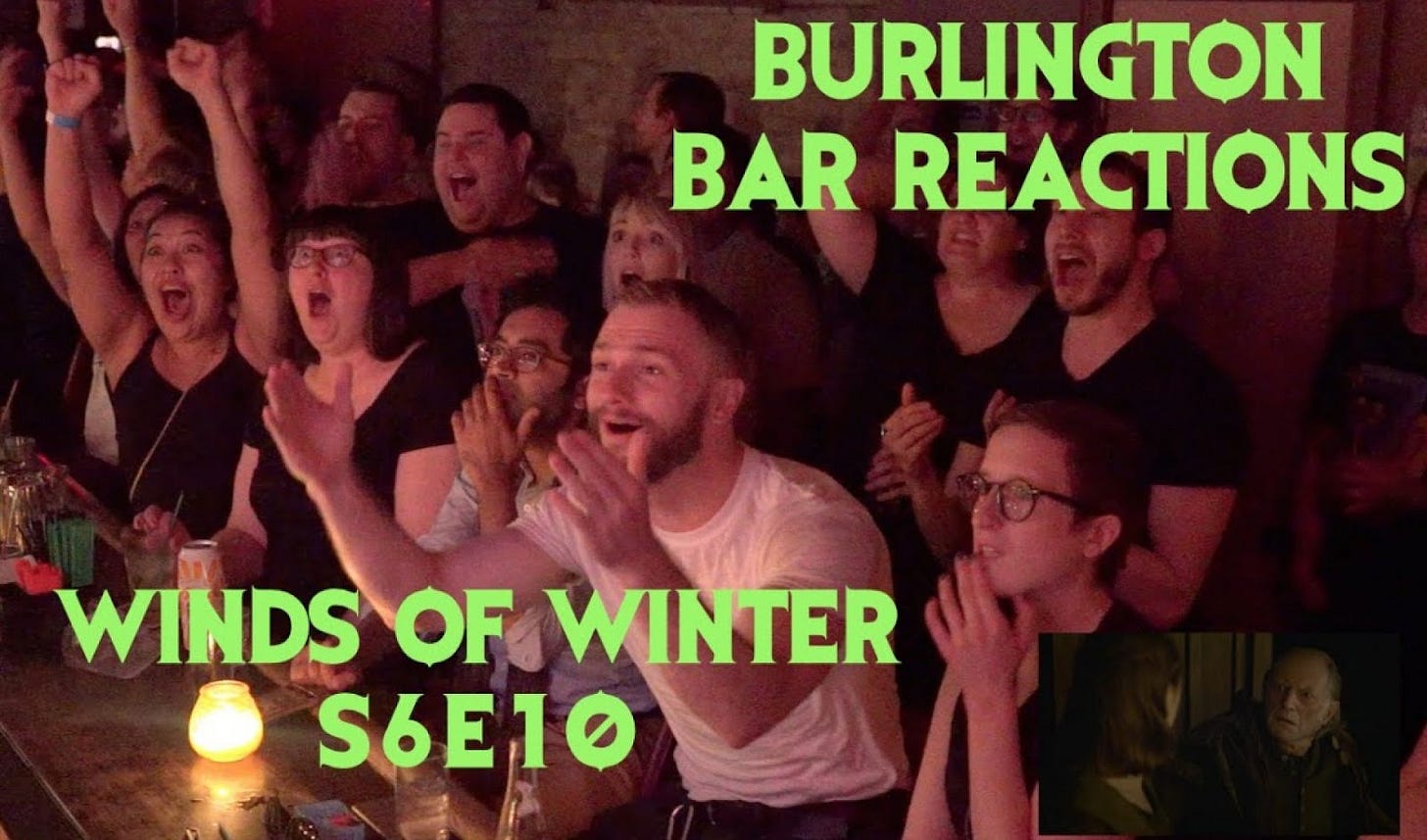A Passionate Reaction Video Creator Shares 5 Helpful Insights
How an Army wife created a community on YouTube with Game of Thrones fans
My husband, David, had been deployed for six months in January of 2016. Although he was close to a hostile zone, we were lucky. We were able to talk every day to stay connected. We shared books we were reading, movies we’d watched, and television shows we wanted to watch when he returned.
“Have you heard of Game of Thrones?” he asked one Sunday afternoon. I hadn’t. Somehow I had been able to avoid the mania that had come to surround the show. I was working to distract myself from his absence, and our two children were in the preteen stage. Plenty to keep me occupied. “You need to watch it. It’s something you’d like.” I had doubted his judgment. It took another month for me to begin the series. And then, the ending of “Winter is Coming” unfolded on my screen…
I was hooked after the first episode.
Insight 1. A New Way to Connect: Video Reactions
My new love for Game of Thrones might have gotten us on the same fandom page but brought other complications. We’d wanted to share the experience together, and since he was still two months from being home, he couldn’t share in my reactions. So I got creative and did what any Army wife would do: I turned on the camera and recorded my reactions as I watched for him. Edited clips were sent via secure emails, and when we spoke, he was able to laugh about my thoughts. We could watch it together… kind of.
The only problem with this system was that I was captivated by the show’s characters and plot. David was a casual watcher and didn’t feel the need to memorize character names or delve into plot lines. He watched for fun, for escapism. But I wanted to know every inch of every nook and cranny the world of Westeros offered. Within two days, I had finished the first season and was ready to consume the next. I found myself aching to talk about the show with others. None of my family or friends watched or wanted to chat about it. I was alone in my theories and obsession. Determined to find a community, I turned to YouTube.
And there, among the usual chaos, I discovered a plethora of fans who were not only watching but recording their reactions to large scenes, just as I had in my own recorded videos for my husband. I found Burlington Bar watch party videos first. At a bar in Chicago, a community assembled every Sunday, en masse, to enthusiastically watch the episodes together. I didn’t click on the video. They were ahead of me by five seasons, and I have a strict no-spoiler rule. But I needed more. I delved further into a side of YouTube I didn’t even know existed and came across FilmBuff's reaction channel. Im Sardar, a Canadian resident, was uploading his real reactions, thoughts, feelings... and his audience approved. Now, I was intrigued.
Insight 2. Creating content for strangers gave me confidence.
Where had I been these last few years? There were people like me who loved to theorize and discuss this show deeper than the surface material. Could I do this? Would anyone want to watch me spill my unedited thoughts? I had only one choice: I had to turn the camera on again. Only this time, I’d post the video hoping to find someone - anyone - to connect with to talk about the show.
I recorded my reaction to an episode, edited it, and uploaded it nervously. I did this as much and as often as I could over the next five years as I became a reaction video creator and grew an audience. And with each post, my confidence grew. My subscribers appreciated my heady discussion. I didn’t just feel accepted; I felt embraced. Viewers appreciated my theories, supported my rants, and shielded me from spoilers. They didn’t think it was strange to upload a video, staring into the camera, speaking to no one in particular. I was speaking to them... and they heard me. We connected. We laughed. We cried together, virtually. Some of these subscribers became my closest friends through this experience and remain so today.
Insight 3. Fans decide which avenues of content creation will thrive.
During this time, the reaction video creator community quickly grew and took on a life of its own. Soon, it wasn’t enough to upload your reaction to one scene. Fans wanted to know all of your thoughts. They wanted to have the total experience. Posting a video of one scene was fine, but it felt like a ploy to grab views. Genuine thoughts, long videos, and authentic discussion was becoming the norm, and natural leaders in thoughtful commentary emerged. George Alexander, UK native and Targaryen enthusiast, who joined in December 2016, became the go-to for Daenerys lovers. American Mum, a.k.a. Michele Harris, a North Carolinian with a gentle disposition, consistently uploaded and quickly worked through the episodes.
By the time I’d reached the end of Season 6, my supportive community had reached 5,000 subscribers, and they remained eager to share my obsession. In January of 2017, I had an idea: what if I live-streamed the finale so they could have a watch party with me, and then we could discuss the episode right afterwards? I posed the idea to my community at the end of my Season 6 Episode 9 video, just as a footnote... a passing thought. I hadn’t seen anyone live-stream a reaction with their community before. Most importantly, I really wanted to get an immediate response to my thoughts and share the excitement for the upcoming Season 7 with my followers. It was received with overwhelming support. A total of 400 people attended the live stream. Modest, yes. But at the time, live-streaming reactions weren’t the norm. I had tapped into something completely new, and it was all because the fans wanted more from the creators they followed. My edited upload remains the second most-watched video on my channel at over 63,000 views; the first, of course, is The Reins of Castamere.
Insight 4. Fans want to expand their own communities and gain fresh perspectives.
Why are fans so interested in watching reaction videos of strangers sitting in a chair in their homes? This is not limited to television shows, after all. Entire channels are committed to this niche. Television shows, movies, and music reactions have become highly sought out despite the fact that watching someone scrutinize a movie or TV show doesn’t sound appealing to the average consumer. What I found is that fans often look to strangers to connect over the stuff they love, especially if their friends and family simply aren’t into the same things.
“I watch a lot of things in general,” said Siddhant Pandey, a former subscriber of my channel, turned friend. “Most of the time, my friends and family haven't seen the things I have… I can view another person watching something I love, and I can live vicariously through them seeing it anew. It's like experiencing it for the first time, since I can't do that.” Watching someone else react to a show you found thrilling, even someone you don’t know personally, feels like watching it again for the first time.
In 2020, Rolling Stone Magazine wrote a short article entitled “How YouTube Reaction Videos are Changing the Way We Listen.” In it, Jonathan Bernstein describes how YouTube reactions have brought attention to songs from past decades. There were, for a long time, channels focused on finding classic songs through reaction listens. But it was a first-time listen to Phil Collins’ In the Air Tonight by Twins The New Trend that catapulted these kinds of reaction videos to the forefront for a new generation of listeners. To date, their video has more than 10 million views and has amassed 888,000 subscribers for them. Fans of these classics can reminisce about the first time they heard the song and, in the comments, provide background, anecdotes, and insight into the music being reviewed. In turn, a fresh perspective, new ideas, and nontraditional thoughts behind the lyrics give seasoned listeners something, perhaps, they feel is long gone: a shared community interacting over something beloved.
Insight 5. The reaction video creator space–and every fandom creator space–is always evolving.
As I sit to decide what my next reaction will be, I am reminded of these facts. The landscape of reactions and watch parties has now changed. Of course, the creator is free to react or watch whatever they deem fun. But the audience and their wants now sway what we, as content creators, decide to watch. “Will my watchers like this? Is it popular? … Do I want to take that into consideration?” I am reminded of the premiere of House of the Dragon. Ten million people tuned in to watch this historical event.
Within two hours, reaction videos were on YouTube.
The audience - the everyday consumer - was ravenous to discuss and share in the experience online with their communities. YouTube reactions and TikToks on House of the Dragon have gone viral, and a pattern takes shape. The television show airs, reactors make videos, the conversation around the show increases, production companies see how the audience responds, and we get more content tailored to those conversations. The cycle continues. The latest phenomenon I have noticed is people with no social media presence commenting on videos and watch parties that have happened since the show aired. The experience exists in perpetuity, with comments from new fans discovering the shows and the videos.
“Are you going to do those video things for House of the Dragon?” David asked as we were beginning our Spring cleaning.
“I hadn’t really planned on it.” I glance over at him as he takes my broom.
“I think you need to watch it.” He gives a knowing smile and walks away.
I sigh. I guess I am reacting to House of the Dragon now.








